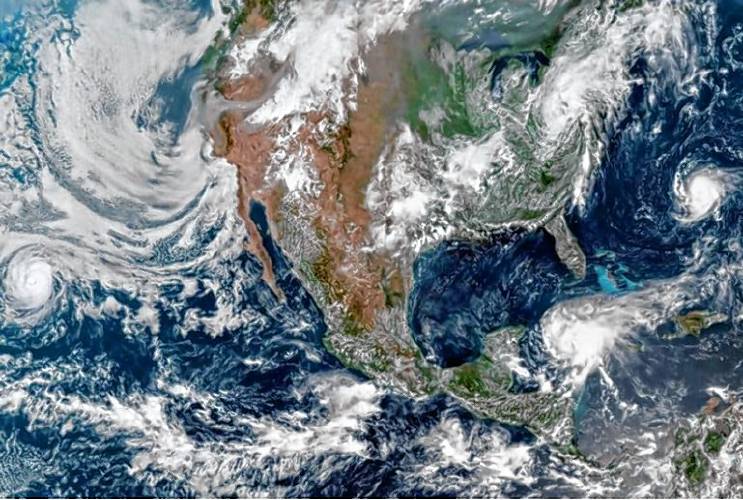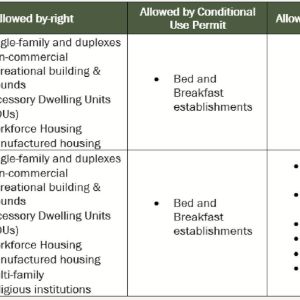Insurers seek shelter from climate change storm

A satellite image of storms churning around North America on Aug. 18, 2021. —NOAA PHOTO
| Published: 01-04-2024 9:24 AM |
The increasing frequency and intensity of natural catastrophes associated with climate change has roiled the insurance industry, executives say.
Testifying before the Senate Budget Committee last year, Eric Anderson, president of Aon, a risk mitigation consulting firm, said flatly “climate change is destabilizing the insurance industry.”
The National Oceanic and Atmospheric Administration reported that in 2022 alone, the United States was struck by 18 weather events traced to climate change, including hurricanes, floods, tornados and wildfires, with losses of at least $1 billion, which altogether amounted to losses of $175.2 billion. By contrast during the decade from 2000 to 2009, the annual average of events with losses of $1 billion or more was 6.7 while annual average losses were $60 billion.
Since January 2022, property insurance premiums have risen by double-digits in 31 states and by between 20 and 30% in six of them, notes Alice Hill of the Council on Foreign Relations. Insurers have declined to renew existing policies or write new ones in states most prone to catastrophic events, notably Florida and California.
Traditional property insurance primarily applies to material damage and indemnifies the insured for the actual value of the loss incurred. The insured assesses the damage and submits a claim, which is reviewed by the insurer then adjusted and validated before ultimately being paid. The process is lengthy, costly and frequently contentious to both insurers and insureds, especially when the damage, like that from natural catastrophes, is severe and widespread.
“The traditional insurance market is especially difficult to navigate,” Anderson writes. “Risk managers and business leaders must be prepared to make better decisions when faced with natural catastrophes, starting with the use of parametric insurance.”
In its simplest terms, parametric insurance pays a predetermined amount based on the measured magnitude of the event as opposed to the assessed value of the loss. These policies cover not only material damage but also can be written to include financial impacts such as lost earnings from interrupted business operations, foregone income to displaced employees and outstanding payments to suppliers and service providers. Above all, payouts are virtually immediate, restoring liquidity and ensuring cash flow.
For example, the characteristics of a storm — the volume of rainfall, force of wind, level of flooding, rise of sea level, size of hailstones — are measured by disinterested, verifiable third parties, particularly government agencies like NOAA and the National Weather Service, immediately after the event. The data serves as the parameters or triggers of the insurance contract. When the parameters are matched or exceeded, payments of amounts specified by the contract are issued promptly.
Article continues after...
Yesterday's Most Read Articles
 Spellers strut their stuff at inaugural Greenfield Spelling Bee
Spellers strut their stuff at inaugural Greenfield Spelling Bee
 Meet the candidates in this year’s Peterborough town election
Meet the candidates in this year’s Peterborough town election
 Mary Lawler remembered for a life of service
Mary Lawler remembered for a life of service
 ConVal track and field makes its one home meet count
ConVal track and field makes its one home meet count
 PHOTOS: The Farm at Wolf Pine Hollow holds TulipFête 2024
PHOTOS: The Farm at Wolf Pine Hollow holds TulipFête 2024
Parametric insurance has grown in fits and starts since the 1990s when several Asian countries began protecting their agricultural sectors against severe weather events. In 2007 the Caribbean Catastrophic Risk Insurance Facility, the first multi-country risk pool, adopted parametric policies to mitigate the financial impact of tropical storms.
A decade later Swiss Re, among the world’s largest reinsurers, introduced typhoon warning insurance for companies in Hong Kong, and the same year French firm AXA began offering parametric insurance against climate risks. By 2020 parametric products providing protection against risks from infectious diseases to natural catastrophes were staples of large insurance companies.
In 2021 the global market for parametric insurance was $11.7 billion and projected to reach $29.3 billion by 2031.
FloodFlash, a firm operating in the U.S. and UK, got its start with the flooding of the New York subway system during Hurricane Sandy. The company outfits its clients’ properties with sensors connected to the Internet that track the water level. When flooding occurs and the parameter is breached, payment is triggered and increases as the water level rises.
The Zurich Insurance Group wrote a parametric policy for a Florida contractor undertaking a project requiring four large crawler cranes that operate at wind speeds at or below a specified level. The policy covered 12 days during the storm season between June and November when the maximum hourly wind speed was 40 miles per hour or more during working hours.
Parametric insurance streamlines the tasks of underwriting policies and processing claims, efficiencies that both reduce the overhead expenses of insurers and ensure timely payouts to insureds. Since claims are triggered by objective, verifiable data the likelihood of contentious disputes is significantly less than that with traditional insurance policies.
The major downside, of parametric insurance is “basis risk,” the possibility that the contractual payout amount is less than the actual loss incurred. With a traditional policy the basis risk is the deductible and with it the risk that the losses will either be excluded altogether or exceed the limits of the policy. With parametric policies the basis risk is greater because the actual losses may fail to trigger the policy altogether.
While parametric policies are most common in the property catastrophe market, they can be written to cover any sort of event that can be objectively measured and causes a loss. For a construction company a policy could be triggered by the number of working days lost to foul weather while for a retailer a policy could be triggered by the decline in sales arising from a pandemic.
Since parametric insurance is data driven, as technology expands capacity to collect and manage data, its applications for quantifying and managing risk expand with it. Policies can be tailored to the particular risk profiles and tolerances of particular insureds, lending a bespoke quality to each contract.
Michael Elliott, a risk management consultant writing in the the Insurance Journal, foresees “The potential for these parametric products is limited only by the risk professionals’ creativity and access to meaningful data.”
Andrew Demers, spokesman for the New Hampshire Insurance Department, said the department has not approved any parametric insurance products.
These articles are being shared by partners in The Granite State News Collaborative. For more information visit collaborativenh.org.

 Voters will soon make their choices
Voters will soon make their choices Grants help farmers implement systems to fight climate change
Grants help farmers implement systems to fight climate change The impact of Peterborough zoning votes
The impact of Peterborough zoning votes Jaffrey Zoning Board approves variance allowing Reality Check to move to residential area
Jaffrey Zoning Board approves variance allowing Reality Check to move to residential area
